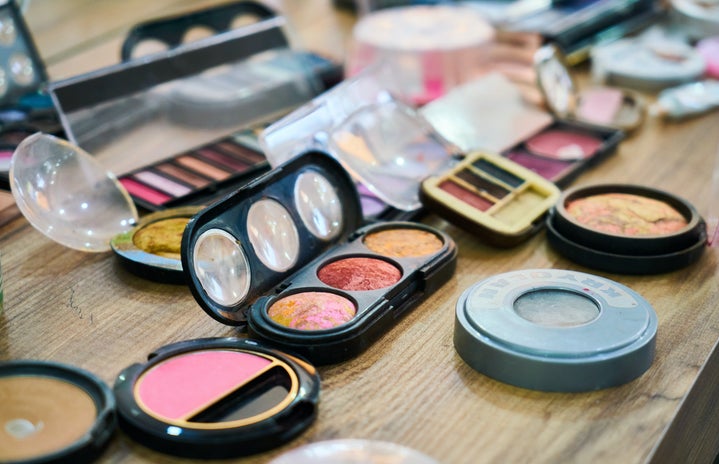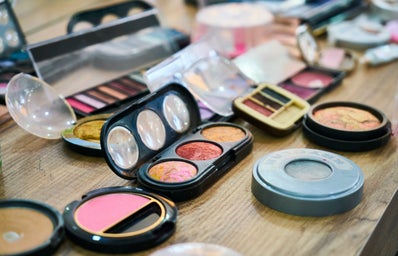This week, for India’s first article with Her Campus, she tackles the consumerism and Makeup Collection trends of the 2000s, commenting on the rise and fall of this within the digital age.
Growing up in the age of technology, many of us may have spent hours on end watching YouTube throughout our teen years, with people such as ‘Zoella’ becoming iconic figures to our generation.
Beauty YouTubers, who later became ‘Beauty Influencers’ reached what many considered to be their peak in the 2010’s, with their most popular videos being makeup tutorials, hauls and ‘makeup collection tours’. The makeup collections of these influencers were immense, spanning whole cupboards and chests of drawers with what can only be described as an excessive amount of makeup products. However, in recent years videos, and in turn the makeup collections they displayed, have lost their popularity.
But why did this style of video fall so far from popularity in recent years?
As previously mentioned, the popularity of ‘Makeup Collection’ videos was at an all time high during the 2010’s. Whether it was makeup they themselves bought, or makeup they were sent in PR, beauty influencers were obsessed with collecting everything from a MAC lipstick to a Too Faced Eyeshadow Palette, filling Ikea drawers with makeup products they would quite possibly only ever use a handful of times, let alone use up before their expiry date. Capitalising off this trend, many companies began to come out with ‘Limited Edition’ collections, which were bought more for the cute packaging than the products themselves.
These extravagant collections went hand in hand with the trends in makeup at the time. The ‘look’ of the 2010’s consisted of a full face. Highlight, ‘sunset’ eyeshadow, and liquid lipsticks were staple items, and sales of Kylie Jenner lip kits skyrocketed. Alongside the YouTube videos, many of these influencers took to platforms such as Instagram to further show off their collections through what was entitled a ‘Shelfie’. In what looking back, had an almost ‘Truman Show’ air to it, influencers would take ‘selfies’ featuring the numerous shelves of beauty products they owned in an attempt to further market these products in a more subtle style.
However, as beauty trends change, and sustainability is brought to the forefront of public debate, the excessive makeup collections that we once obsessed over have not only fallen out of fashion but “have received some much-deserved criticism”.
Speaking to Vice, influencer and makeup artist Painted by Esther claimed that within the industry there “is pressure on artists to have a large collection. It’s like a status. The more high-end items you have, the better you’re viewed.” And through beauty influencers, this overconsumption has trickled down to millions of viewers, with detrimental effects on the environment. According to Zero Waste Europe, an estimated 120 billion units of packaging is created every year, and as little as 9% of plastic ever produced by any industry has been recycled.
In an attempt to tackle this issue many companies such as Maybelline have placed ‘makeup recycling bins’ in shops nationwide, alongside popular YouTuber’s such as Kelly Gooch and Serein Wu promoting initiatives such as #NoBuy, #LowBuy or #ShopMyStash.
Now, according to a poll by weDo/ Professional, 54% of consumers consider sustainability a key factor when buying beauty, hair and skin care products, with more than half believing it is important to look for products with recyclable packaging.
This switch to minimalism and sustainability seemingly comes hand in hand with new beauty trends emerging on platforms such as YouTube, Instagram, and more recently, TikTok.
The ‘Clean Girl’ or ‘Off-duty Model’ makeup look requires minimal makeup products, and its popularity has led to an increase in people going for a more ‘natural’ look when it comes to their makeup. Whilst this minimalist approach to beauty has been praised by many for promoting a more sustainable lifestyle, it comes hand in hand with the increase in beauty consumerism of another form: skincare.
The skincare industry “is growing faster than any other part of the beauty industry”, and a lot of beauty influencers have moved from YouTube to the short form videos of TikTok to discuss their skincare recommendations which will enable us all to achieve the ‘perfect clean girl look’. This has resulted in many purchasing any and every skincare product they are recommended, regardless of whether these products cater to their skin type or issues, leading to an increase once again in the excessive consumerism of the beauty industry and the waste it produces.
Either way, whether you enjoy a full glam moment, or the ‘Clean Girl’ minimalism trending on TikTok, be wary of the products you’re purchasing. Evaluate whether you really want, or need, that new moisturiser, or whether you can save those pennies, and in turn the planet, by waiting on a product that you will well and truly love.
SOURCES:
https://fashionjournal.com.au/
https://www.vice.com/en/article/ne8vkb/beauty-influencers-environmental-impact
https://www.zerowaste.com/zero-waste-home-guide/
https://www.terracycle.com/en-GB/brigades/maybelline-uk


